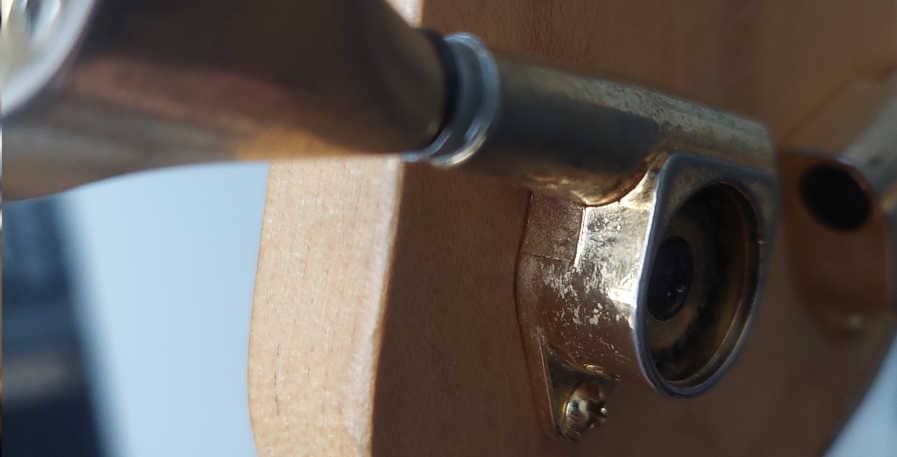A proper string setup is important for both the playability and sound of your bass. An often overlooked part of this setup is how the strings should be fastened to the bass. In particular, how many times should a bass string be wrapped around the tuning peg?
While different strings and basses require unique setups, a bass string should generally be wrapped 2-3 times around its tuning peg. In general, thinner bass strings need to be wrapped around the peg more times than thicker ones.
Oftentimes, you will not go wrong if you wrap every bass string 3 times around the peg. However, this will not hold true in all cases. Furthermore, while wrapping every string 3 times might work, this doesn`t mean that it is the optimal way to do it.
Therefore, I`m going to show you what to look for when fastening your bass strings. This way, you will be able to easily set up your bass strings so that they won`t break loose and so that your instrument feels easier to play.
Why bass strings should wrap 2-3 times around tuning pegs
When I was younger and didn`t know what I was doing, I usually did one, or sometimes even half of a wrap. While no strings got loose in for the years I was doing it, there were 3 problems with this method:
- Mileage may vary – It`s best to set up your bass to make it as robust and playable as possible. Insufficient string wrapping increases the chance that the string will slip from the peg. Having your string detune or get loose during a live show is a nightmare, and proper wrapping will decrease the chance of that ever happening.
- String trees – Basses without a string tree part require certain strings to be wrapped around the tuning peg as many as 4-5 times. In these cases, the string will be even more prone to slipping if it`s just wrapped 1 time around the peg.
- Break Angle – Break angle is the direction your string angles from the nut to the headstock. Wrapping your string around all or most of the tuning peg will result in a more preferable break angle. This improves both the tuning stability of your bass and makes the tone of the instrument more resonant.
Some bassists prefer cutting the strings prior to wrapping them on the pegs. Do however remember that if you cut the string too short you can not undo it. Thus, it can be a good idea to wrap the string prior to cutting it.
On some basses, the A string will need to be wrapped more times than the other strings. This is due to A string tuning peg`s position relative to the nut, and not having a string tree.
Wrapping it more times will thus give it a more preferable break angle. This will be the case for most Fender basses, and basses where the tuning pegs are all located at the same side of the headstock.

How to wrap bass strings around the tuning pegs
Once a bass string is threaded through the bridge do the following to wrap it around the tuning pegs on the headstock.
- Lay the string out – First, extend the string straight from the bridge across the fretboard of your bass.
- Cut the string (optional) – Some bassists prefer cutting the string at this point. I recommend waiting with this part if you haven`t done it before, or if you are trying out a new type of strings or bass. If all your machine heads are on one side of the headstock, cut them 2 machine heads up. I.e cut the string at the D machine head for your E string, etc. If your headstock has a different layout, cut the strings at about 3 1/2 inches (9cm) from the tuning peg. Remember that it`s better to cut too little than too much.
- Thread the string through the eyelet – Now insert the string through the eyelet in the tuning peg. You want to give the string a little bit of space where it exits the tuning peg. Just a little bit of space; 1/16″ (1.5cm) is sufficient.
- Wrap the string – Now wrap the string around the tuning peg. Wrap the string from the top down and avoid wrapping it on top of itself. When the string is cut at the appropriate length it should wrap 2-4 times around the peg in most cases. If you have erred on the safe side on cutting, wrap it the appropriate amount of times and cut the string afterward.
- Tune your bass – When every string has been wrapped around its respective tuning peg it`s time to tune your bass. Do it slowly and carefully, as strings are generally more prone to snapping when they are newly strung.
I prefer stringing the thickest string first, the second thickest second, and so forth. I also recommend wrapping every string and then tuning the bass afterward. This makes the whole process more efficient and lets you focus on one thing at a time.
How to keep bass pegs from slipping
In general, the tuning pegs on a bass can be prevented from slipping by having a correctly cut nut and ensuring that the pegs are properly secured. Strings should also not have any overlap in their wrapping around the tuning pegs as this can further increase the chance of them slipping.
When strings are wrapped incorrectly or there is an issue with the setup of your bass, you might experience the tuning pegs slipping. This means that they “tune” themselves on their own, which detunes your bass.
The first step to avoid this is to wrap your strings correctly. Follow the tips outlined above, and do not double-wrap your strings so that there is an overlap in the wrapping.
If you do that and you still notice that the tuning pegs are slipping, do the following:
- File the nut (if needed) – The nut is the small plastic part where your strings rest between your neck and headstock. If the cuts in it are too small for your strings, this can increase the chance that your pegs will start slipping. Thus, if the strings are not sitting compactly in the cuts, file them carefully till they can fit the strings properly.
- Screw in tuning pegs – Another reason your pegs could be slipping is that they are simply not secured tightly enough. You will screws on the backside of the headstock that you can use to tighten the tuning pegs. While every bass is different, most tuning pegs can easily be tightened with a small screwdriver.
Also, if you have just restringed your bass or switched to an alternate bass tuning your bass will generally spend some time adjusting. This also means that you will have to tune your bass more often.
The need to retune will diminish over time and is not to be confused with there being an issue with your wrapping or tuning pegs.
Conclusion
So how many times should a bass string wrap around a tuning peg? Ideally, 2-3 times with thicker strings leaning more towards 2 than 3, and thinner strings more towards 3 than 2. Fender and similar model basses will need the A string to be wrapped 4-5 times.
This is not to say you can`t wrap it fewer times, I did so for years. However, in hindsight, I realize that this increased the chance of the tuning pegs slipping and made my instrument sound less resonant.
Getting string wrapping right is thus all about getting the most out of your instrument. Insufficient wrapping will rarely if ever, ruin the sound or playability of your instrument. Proper wrapping will however decrease the chance of the strings slipping and will improve the resonance and tone of your bass.

